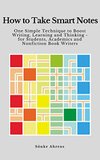How to Take Smart Notes: One Simple Technique to Boost Writing, Learning and Thinking – for Students, Academics and Nonfiction Book Writers
amazon.com
How to Take Smart Notes: One Simple Technique to Boost Writing, Learning and Thinking – for Students, Academics and Nonfiction Book Writers

The first step is to break down the amorphous task of “writing” into smaller pieces of different tasks that can be finished in one go.
Having a clear structure to work in is completely different from making plans about something.
If Darwin had never abstracted from his concrete observations of sparrows, he would never have found an abstract, a general principle of evolution across different species, and he would never have been able to see how evolution works in other species as well. Abstraction is also not for theoretical-academic processes of insight only. We need to abs
... See moregood structure allows you to do that, to move seamlessly from one task to another – without threatening the whole arrangement or losing sight of the bigger picture.
In his book “The Paradox of Choice,” Barry Schwartz used numerous examples, from shopping to career options to romance, to show that less choice can not only increase our productivity, but also our freedom and make it easier to be in the moment and enjoy it (Schwartz, 2007).
Another piece of advice is not a feature of the slip-box and might sound banal, but it is crucial: Make sure that you really see what you think you see and describe it as plainly and factually as possible. Double-check if necessary.
The biggest threat to creativity and scientific progress is therefore the opposite: a lack of structure and restrictions. Without structure, we cannot differentiate, compare or experiment with ideas. Without restrictions, we would never be forced to make the decision on what is worth pursuing and what is not. Indifference is the worst environment f
... See moremanuscript, you will improve your reading, thinking and other intellectual skills just by doing everything as if nothing counts other than writing.
Since writing is nothing more than the revision of a rough draft, which is nothing more than turning a series of notes into a continuous text, which are written on a day-to-day basis, connected and indexed in the slip-box, there is no need to worry about finding a topic to write about. Just look into your slip-box and see where clusters have been b
... See more